(a.k.a. Journey Through Landscape through Cézanne’s eyes)
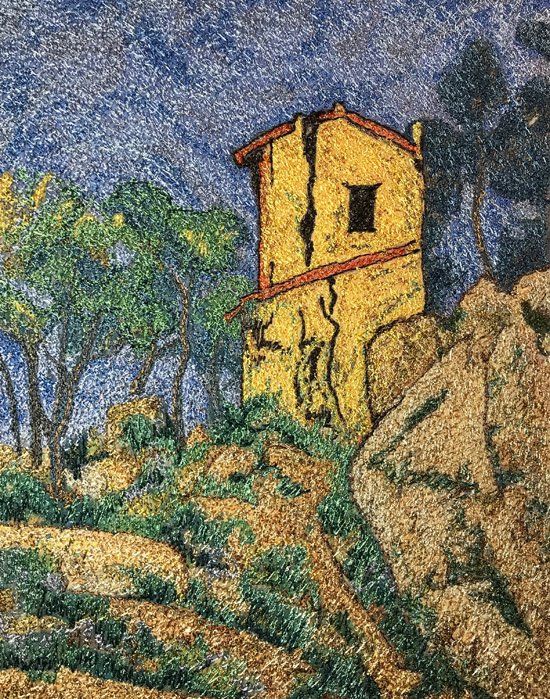
[Note: ‘The House with Cracked Walls’ by Paul Cézanne is used with permission; licensed under Creative Commons Zero—CCO—and released in the Public Domain]
Obsession with Impressionism
Anyone who’s followed me for a while will know that I love the art of the Impressionists, and much of my thread painting is heavily influenced by their techniques and strategies.
Cézanne’s painting exudes a soft glow, with largely muted colours, yet a surprising range of shades was required to reproduce it as best I could.
So what can we learn from them that we can use in our thread paintings?
1. Colour and hue
I know I talk ad infinitum about colour, and that’s because:
- I’m fascinated with how colours work together, and
- It’s so vitally important to the way we approach any new thread painting projects.
Colour tells you a lot about mood and emotion, distance, perspective, and even the artist. In music you can deduce from the sound (colour of the music), the way the music is arranged, the instrumentation, tempo, etc., how the composer was feeling at the time—joy, anger, happiness, despair, rejoicing …
Just as in music, so in art.
The Impressionists used colour to represent mood, atmosphere, time of day—the softness of dawn, the starkness of the sea, the hardships of peasant life, and, of course, the lively, somewhat risqué Parisian scene at the time!
Colour was often exaggerated, with warm golds abutting cool blues and greens. Colours mix in the viewer’s eye to blend and create more colours. Just as when mixing paint, mixing thread colours by overstitching, while allowing under-colours to show through, creates a similar effect.
Dull and muddy colours offset and enhance more dominant colours.
Darker colours and tones create depth.
Surprising colours are often found—for example, when you see purples and mauves being used for shadows, as opposed to the more anticipated greys.
Here are some of the colours I used in reproducing Cézanne’s work. Looking at them, you’d think they are mostly what you’d expect to find in this work.
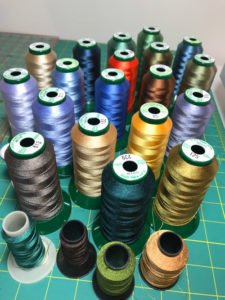
The interest lies in trying to emulate the way Impressionists used colour, with the use of unexpected or surprising colours.
Look closely at Impressionist works—especially those of Monet—and you’ll notice many surprising colours—little dabs of red in water, green and blue in walls …
Below is an approximate breakdown of the colours I used here to create the texture and depth in the work—and tried to pretend (just for a fleeting moment), that I was observing this scene through the eyes of Cézanne. (Wouldn’t that be nice!).
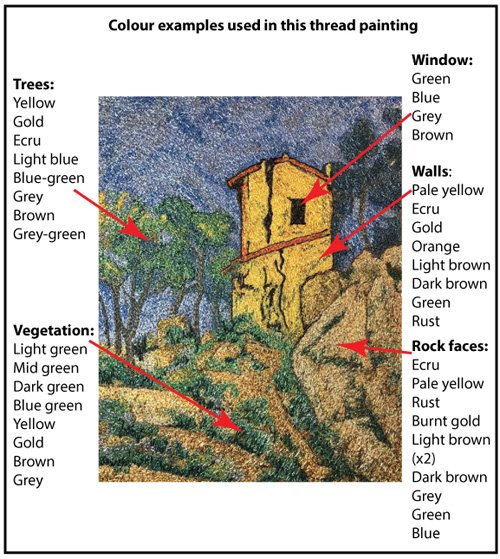
2. Illusion, Atmosphere, and Depth
Early Impressionists rebelled against the traditions and formal teaching strategies of the late Classical artists, seeking ways to represent the reality of everyday life in their work.
Impressionism brought forth a new way to use colour in paintings—sometimes softer, sometimes more vibrant, and always enticing and interesting.
They sought to avoid detail, using bold and broad brush strokes to create an interpretation, an illusion or ‘impression’ of the scene before them.
Atmosphere was of greater importance than detail. Depth was created with the clever use of colour.
3. Mixing colour—the fabric becomes your palette
When thread painting we must learn to mix colour like an artist, but instead of mixing on a palette, the fabric is our palette.
Free motion zigzag stitch, as used here, due to its very ‘zigzag’ nature, allows for the necessary build-up, mixing and blending of colours required to create tonal variety and depth.
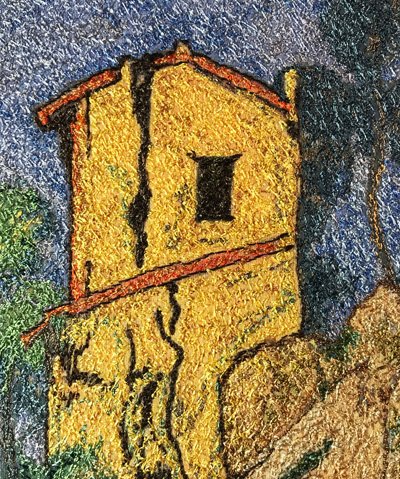
Threads lie at random angles, stitches are random lengths, there is no uniformity in stitch size or shape, nor the way they ‘sit’ on the fabric. Therefore, threads show through the layers they sit behind.
Sometimes darker colours will lie to the back, or bottom layer. If these are too powerful, dark colours can be ‘knocked back’ or toned down with the random application of other shades over the top.
At other times, I will ignore convention (of working dark colours first, therefore forming the bottom layer) and begin with light colours. This has the effect of creating a translucency, flecks and specks of light that shine and sparkle through upper layers, catching the eye.
Observe and experiment
Every time you begin a new thread painting, be bold and experimental with the way you use colour. The Impressionists had to tolerate years of ridicule from the traditionalists, until eventually their greatness was recognised.
Regardless of whether Impressionism, or some other, is your preferred style, being inspired and influenced by works of the great artists can lead to many personal revelations in the way you blend and mix colours on your fabric palette.
Thanks for visiting!
A word of caution—if you’re going to use other people’s work as a personal educational tool, be sure to source images that are in the Public Domain so that there is no breach of copyright.
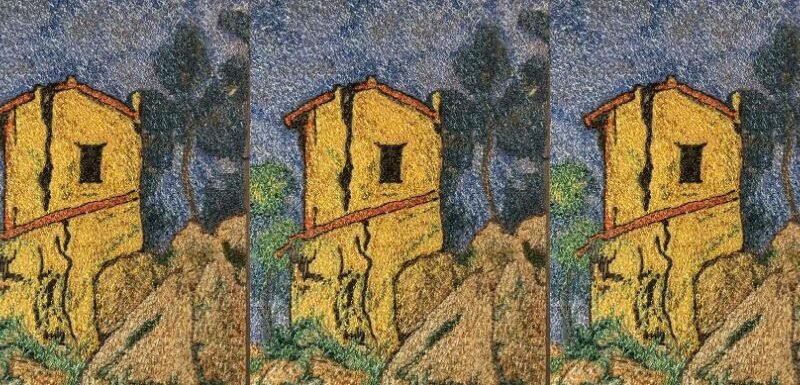
Thanks so much this makes so much sense. Last weekend I purchased one of the eight drawer storage units on casters from Micheles to organize my thread.
Hi Barbara – Great that this resonated with you. And I agree, storage drawers are great for organizing thread. I do that, too!
Deborah, your words have uplifted me even describing music, which I love and p;onder a lot on. Your are adding to your workload in ways we can enjoy and understand and I am so grateful for your wellbeng. Maria
Hi Maria – thank you for your kind words! It’s impossible, sometimes, for me to keep music out of my conversations — playing the viola, especially for opera, has occupied a large part of my life (and still does!). I’m so pleased I’ve been able to bring a little joy to your day 🙂 Deborah
I am in awe of the talent involved in completing a project of this magnitude!
Hi Mary, thankyou—and I’d like to encourage you to give it a go. Try something simple first, and work up to more challenging projects.
Absolutely lovely very informative your book is arriving tomorrow thankyou so very much for sharing I think you are fantastic
Hi Carol – I’m glad this article has offered you something useful (that’s always my aim!), and thank you for ordering my book. Much appreciated 🙂
Ok Deborah. Love your work and now I am committed to aim for your level of excellence . Sure do appreciate your tutorial and will get started. Thanks again
Hi Diannah – I have every confidence that if you take it one step at a time—start with something simple and work from there—you will achieve what you aspire to! I didn’t get there without patience and perseverance!
I am absolutely in awe of your talent. I would never have thought of attempting an actual painting. Your work is so amazing and your remarks are really helpful.
Hi Pat – thank you for your comments. You know, why don’t you give it a try – perhaps something a little less complex than this, at first, if you like … however, we all learn by doing—me included! I learn something new every time.
You are amazing and you have made me think to look in depth to the picture or painting and study what lies beneath, how the colours build, how you would not think of using a certain colour but it works. You are just so good.
I love the book can’t wait to get started. Thank you Jan
Hi Jan – I so pleased my words have resonated with you—I did find it challenging to describe what I was feeling! And thank you for supporting my work and my book. 🙂 Deborah
Hi Deborah,
yes, starting with light colours and ‚overpainting‘ with darker! That I will experiment next. Thank you for your tips and congratulation to your book!
Hi Barbara – glad you like the idea of light under dark — it can create a really lovely effect with lots of depth!
Fantastic work as usual Deborah and thanks for your insight into the Impressionists use of colour!
Like you I’m also concerned about copyright, so I’m glad you made this point clear and also where you obtained the picture from.
Hi Christine – I’m pleased you found my article interesting, and yes, I agree about copyright—it’s (sadly) something that too many people don’t take enough care about.
Dear deborah, i have dabbled with free motion stitching since the 1980s. Ive used it for years in quilting. It is so freeing in creating. Your lessons are so simple and informative, thanks. We are krindred spirits in loving the impressinests. I think they freeed the art world no matter what direction they took.
I am recovering from a back injury and sitting at a machine is difficult. I will get back and try to do more thread painting. Only God and me will be seeing it fir awhile, and we are not going to be critical of the results. Have a great week. Gloria
Hi Gloria – Thank you for your kind words … I hope your back injury heals soon so that you can get back to thread sketching again – it’s such an enjoyable pastime. And yes, I agree about the Impressionists. Without their courage to stand up to convention, who knows where art would still be now? And please don’t ever be critical of your work, it’s a journey. Put one foot (or stitch!) in front of the next and keep learning! 🙂 Deborah
Hello Deborah:
Your work is absolutely incredible. Did you do this on a simple sewing machine?
Enjoying your sharing this with us.
Thank you
Carina Gatto
Hi Carina – yes, this was all worked on a regular machine using free motion zigzag stitch.
Debra you continue to amaze me. I appreciate how you have explained the use of color and hue and brush strokes in impressionistic painting. Absolutely love your work and this explanation will help me greatly when quilting and composing quilt design. (using EQ8) I have been doing a lot of improv piecing to create quilts for friends and family and sometimes get stuck on combing fabrics and color. Much love to you for this.:)
Hi Shann – thank you for your lovely comments. Your designs on EQ sound interesting so I’m pleased that some of my words are helping you.
Many thanks for your inspirational guidance Deborah. I’m also a professional musician (pianist) so your comments resonate (pardon the pun!) well with me. I’m also a painter but not at the same level.
I have a query re how to avoid puckering with very dense stitching. Do you have a solution you could share please? I absolutely LOVE doing thread painting but this aspect really frustrates me.
Many thanks for your wonderful guidance. ☺️Josephine in Perth. Originally from Auckland NZ.
Hi Josephine — nice to hear from a fellow musician! Sometimes it’s difficult to avoid the puns!